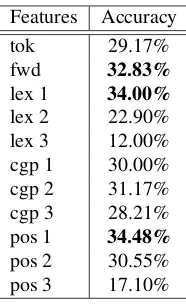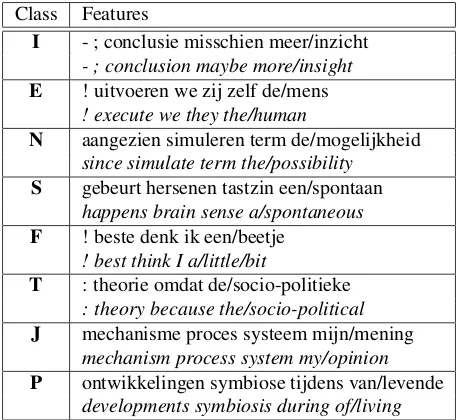Personae: a corpus for author and personality prediction from text
Kim Luyckx, Walter Daelemans
CNTS Language Technology Group University of Antwerp Prinsstraat 13, 2000 Antwerp, Belgium {kim.luyckx, walter.daelemans}@ua.ac.be
Abstract
We present a new corpus for computational stylometry, more specifically authorship attribution and the prediction of author personality from text. Because of the large number of authors (145), the corpus will allow previously impossible studies of variation in features considered predictive for writing style. The innovative meta-information (personality profiles of the authors) associated with these texts allows the study of personality prediction, a not yet very well researched aspect of style. In this paper, we describe the contents of the corpus and show its use in both authorship attribution and personality prediction. We focus on features that have been proven useful in the field of author recognition. Syntactic features like part-of-speechn-grams are generally accepted as not being under the author’s conscious control and therefore providing good clues for predicting gender or authorship. We want to test whether these features are helpful for personality prediction and authorship attribution on a large set of authors.
Both tasks are approached as text categorization tasks. First a document representation is constructed based on feature selection from the linguistically analyzed corpus (using the Memory-Based Shallow Parser (MBSP)). These are associated with each of the 145 authors or each of the four components of the Myers-Briggs Type Indicator (Introverted-Extraverted, Sensing-iNtuitive, Thinking-Feeling, Judging-Perceiving). Authorship attribution on 145 authors achieves results around 50% accuracy. Preliminary results indicate that the first two personality dimensions can be predicted fairly accurately.
1.
Introduction
The style in which a text is written reflects an array of meta-information concerning the text (e.g. topic, register and genre) and its author (e.g. gender, region, age and personal-ity). The field of computational stylometry addresses these aspects of style. We approach stylometry as an automatic text categorization task that labels documents according to a set of predefined categories (Sebastiani, 2002). Like most text categorization systems, it takes a two-stage approach which (i) achieves automatic selection of features that have high predictive value for the categories to be learned, and (ii) uses machine learning algorithms to learn to categorize new documents by using the features selected in the first stage. To allow the selection of linguistic features rather than (n-grams of) terms, robust and accurate text analysis tools such as lemmatizers, part of speech taggers, chun-kers etc., are necessary. Recently, language technology has progressed to a state of the art in which this has become feasible. This enables the systematic study of the varia-tion of these linguistic properties in texts by different au-thors (Baayen et al., 1996), time periods, genres or regis-ters (Argamon et al., 2003a), regiolects, and even genders (Argamon et al., 2003a).
In this paper, we focus on personality prediction and au-thorship attribution. A lot of the research in auau-thorship at-tribution is performed on a small set of authors, which is an artificial situation. Trying to classify an unseen text as being written by one of two or a few authors is a relatively simple task, which in most cases can be solved with high reliability and accuracies over 95%. Hardly any corpora - except for some based on blogs (Koppel et al., 2006) or Usenet newsgroups (Argamon et al., 2003b) - have more than ten candidate authors. Forensic experts typically use stylometry to indicate which of a small number of suspects
is the most likely to have written a short text, without being able to rule out the fact that there might be other people in play. Many studies in stylometry overestimate the impor-tance of linguistic features in experiments discriminating between only two or a small number of authors. We devel-oped thePersonaecorpus to investigate this phenomenon. Documents written by 145 authors allow us to investigate the performance of authorship attribution on a large set of authors.
The corpus is also used for the prediction of the author’s personality, a not yet very well researched aspect of style. Our aim is to test whether personality traits such as ex-traversion are reflected in writing style. Studies in language psychology show that there is a direct correlation between personality and language: personality is projected linguis-tically and can be perceived through language (Gill, 2003; Gill and Oberlander, 2002; Campbell and Pennebaker, 2003). These studies are however not in a prediction con-text, but in a descriptive statistics context. The main focus is on extraversion and neuroticism, two of ”the most salient and visible personality traits” (Gill, 2003). We want to take the study of personality in text further in three ways:
i. By collecting texts on a non-personality related topic, in this case artificial life. A number of studies in per-sonality prediction and language psychology rely on stream-of-consciousness essays or deep self-analysis (Argamon et al., 2005; Mairesse et al., 2007), and even texts about traumatic experiences (Campbell and Pen-nebaker, 2003). We also did no extensive cleaning-up of the corpus, in contrast to Nowson and Oberlander (2007).
Task Features Precision Recall F-score Accuracy
I lex 3 56.70% 84.62% 67.90% 64.14%
random 44.1% 46.2%
E cgp 3 58.09% 98.75% 73.15% 60.00%
random 54.6% 52.5%
N cgp 3 56.92% 94.87% 71.15% 58.62%
random 48.7% 48.7%
S pos 3 50.81% 94.03% 65.97% 55.17%
random 40.3% 40.3%
F lex 3 73.76% 99.05% 84.55% 73.79%
random 72.6% 73.3%
T lex 3 40.00% 50.00% 44.44% 65.52%
random 28.2% 27.5%
J lex 3 81.82% 100.00% 90.00% 82.07%
random 77.6% 76.9%
P lex 2 26.76% 67.86% 38.38% 57.93%
random 6.9% 7.1%
Table 5: TiMBL results for eight binary classification tasks
Class Features
I - ; conclusie misschien meer/inzicht
- ; conclusion maybe more/insight E ! uitvoeren we zij zelf de/mens
! execute we they the/human
N aangezien simuleren term de/mogelijkheid
since simulate term the/possibility S gebeurt hersenen tastzin een/spontaan
happens brain sense a/spontaneous F ! beste denk ik een/beetje
! best think I a/little/bit
T : theorie omdat de/socio-politieke
: theory because the/socio-political J mechanisme proces systeem mijn/mening
mechanism process system my/opinion P ontwikkelingen symbiose tijdens van/levende
developments symbiosis during of/living
Table 4: Predictive features per personality type (with En-glish translation)
test instances can be classified. We present random and majority baselines. For Tables 5 and 6, the micro-average of every element in the contingency table over the ten folds was calculated. An example of some lexical predictive fea-tures for the personality types is presented in Table 4.
In Table 5, the personality prediction system is evaluated in terms of precision, recall, F-score, and accuracy, in order to get good grip on the system’s performance. In heav-ily skewed classes, accuracy is less suitable to evaluate the system, because it does not take class distributions into ac-count. Precision indicates the number of correctly classified instances of the positive class (resp., I, E, N, S, F, T, J, P), while recall represents the number of incorrectly classified negative instances (resp., not-I, not-E, not-N, not-S, not-F, not-T, not-J, not-P). F-score is the harmonic weighted mean of precision and recall, and accuracy indicates the number
of correctly classified instances over the positive and nega-tive classes. Results in accuracy are reported just for com-pleteness, but we will not use them in our analyses since they are unfit for dealing with skewed classes.
The results in Table 5 reveal that four of the eight classes achieve an F-score of around 70% with the best scoring fea-ture set. For heavily skewed classes with almost no coun-terexamples like F (only 28% of the instances is negative) and J (18% of the instances is negative), results are high, as expected (cf. random baselines). They vary between 85% and 90% F-score. For classes with hardly any positive in-stances, results are low, viz. 44% for F and 38% for P.
Task Feature F-score F-score Avg. Acc.
set [INFJ] [ESTP] F-score
I/E lex 3 67.53% 63.24% 65.38% 65.52%
random 49.7%
majority 55.2%
N/S pos 3 58.65% 64.97% 61.81% 62.07%
random 44.8%
majority 53.8%
F/T lex 3 84.55% 13.64% 49.09% 73.79%
random 60.7%
majority 72.4%
J/P lex 3 90.00% 13.33% 51.67% 82.07%
random 63.5%
majority 80.7%
Table 6: TiMBL results on four discrimination tasks
K. Luyckx and W. Daelemans. 2005. Shallow text analysis and machine learning for authorship attribution. In Pro-ceedings of the fifteenth meeting of Computational Lin-guistics in the Netherlands (CLIN 2004), pages 149–160. K. Luyckx, W. Daelemans, and E. Vanhoutte. 2006. Sty-logenetics: clustering-based stylistic analysis of literary corpora. InProceedings of the 5th Language Resources and Evaluation Conference: Workshop ”Towards Com-putational Models of Literary Analysis” (LREC). D. Madigan, A. Genkin, D. Lewis, S. Argamon, D. Fradkin,
and L. Ye. 2005. Author identification on the large scale. InProceedings of the 2005 Meeting of the Classification Society of North America (CSNA).
F. Mairesse, M. Walker, M. Mehl, and R. Moore. 2007. Us-ing lUs-inguistic cues for the automatic recognition of per-sonality in conversation and text. Journal of Artificial Intelligence Research, 30:457–500.
R. McCrae and P. Costa. 1989. Reinterpreting the Myers-Briggs Type Indicator from the perspective of the Five-Factor Model of Personality. Journal of Personality, 57(1):17–40.
A. Miranda Garc´ıa and J. Calle Mart´ın. 2007. Function words in authorship attribution studies. Literary and Lin-guistic Computing, 22(1):49–66.
S. Nowson and J. Oberlander. 2007. Identifying more bloggers. Towards large scale personality classification of personal weblogs. In Proceedings of the 2007 In-ternational Conference on Weblogs and Social Media (ICWSM).
F. Sebastiani. 2002. Machine learning in automated text categorization. Association for Computing Machinery (ACM) Computing Surveys, 34(1):1–47.
E. Stamatatos, N. Fakotakis, and G. Kokkinakis. 2001. Computer-based authorship attribution without lexical measures. Computers and the Humanities, 35(2):193– 214.


